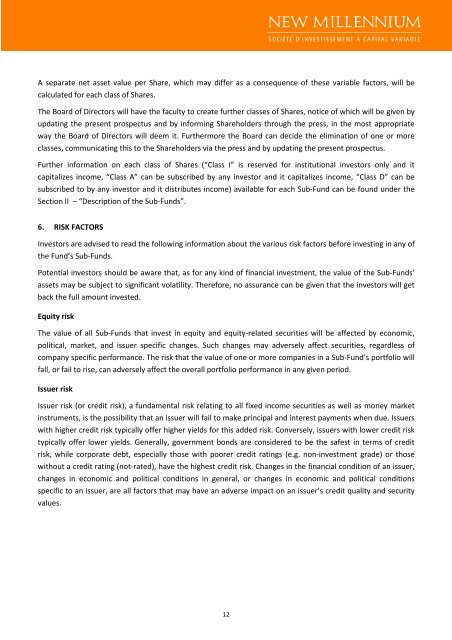PC NMS October 2012 clean version CSSF 3010 pour VISA FINAL
PC NMS October 2012 clean version CSSF 3010 pour VISA FINAL
PC NMS October 2012 clean version CSSF 3010 pour VISA FINAL
Create successful ePaper yourself
Turn your PDF publications into a flip-book with our unique Google optimized e-Paper software.
A separate net asset value per Share, which may differ as a consequence of these variable factors, will be<br />
calculated for each class of Shares.<br />
The Board of Directors will have the faculty to create further classes of Shares, notice of which will be given by<br />
updating the present prospectus and by informing Shareholders through the press, in the most appropriate<br />
way the Board of Directors will deem it. Furthermore the Board can decide the elimination of one or more<br />
classes, communicating this to the Shareholders via the press and by updating the present prospectus.<br />
Further information on each class of Shares (“Class I” is reserved for institutional investors only and it<br />
capitalizes income, “Class A” can be subscribed by any investor and it capitalizes income, “Class D” can be<br />
subscribed to by any investor and it distributes income) available for each Sub-Fund can be found under the<br />
Section II – “Description of the Sub-Funds”.<br />
6. RISK FACTORS<br />
Investors are advised to read the following information about the various risk factors before investing in any of<br />
the Fund’s Sub-Funds.<br />
Potential investors should be aware that, as for any kind of financial investment, the value of the Sub-Funds’<br />
assets may be subject to significant volatility. Therefore, no assurance can be given that the investors will get<br />
back the full amount invested.<br />
Equity risk<br />
The value of all Sub-Funds that invest in equity and equity-related securities will be affected by economic,<br />
political, market, and issuer specific changes. Such changes may adversely affect securities, regardless of<br />
company specific performance. The risk that the value of one or more companies in a Sub-Fund’s portfolio will<br />
fall, or fail to rise, can adversely affect the overall portfolio performance in any given period.<br />
Issuer risk<br />
Issuer risk (or credit risk), a fundamental risk relating to all fixed income securities as well as money market<br />
instruments, is the possibility that an issuer will fail to make principal and interest payments when due. Issuers<br />
with higher credit risk typically offer higher yields for this added risk. Conversely, issuers with lower credit risk<br />
typically offer lower yields. Generally, government bonds are considered to be the safest in terms of credit<br />
risk, while corporate debt, especially those with poorer credit ratings (e.g. non-investment grade) or those<br />
without a credit rating (not-rated), have the highest credit risk. Changes in the financial condition of an issuer,<br />
changes in economic and political conditions in general, or changes in economic and political conditions<br />
specific to an issuer, are all factors that may have an adverse impact on an issuer’s credit quality and security<br />
values.<br />
12


